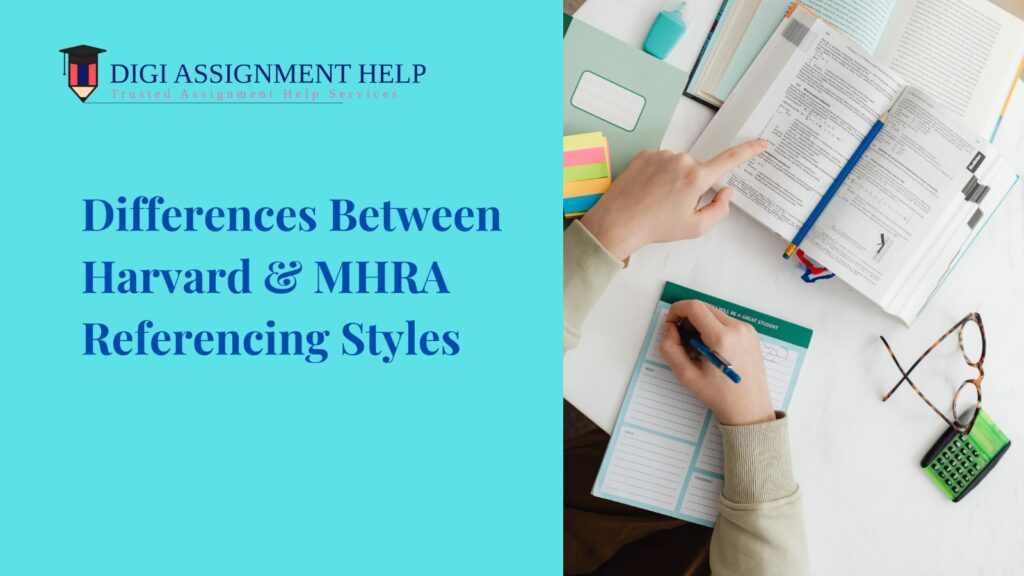You need to reference your work to prove that substantial research has been done to support your analysis. To give credit to other people’s work to enable others to follow up on your work. And also, to avoid plagiarism. Plagiarism is the act of presenting the work or ideas of another as your own.
There are two elements to referencing. First is the use of in-text citations and second is the reference list. The in-text citation is when you refer to someone’s work in your essay. This is normally the surname of the author and the year their work was published. The reference list comes at the end of your work and details all the resources you’ve referred to in your essay.

MHRA
MHRA style is a set of referencing guidelines commonly used in humanities subjects. The sources you use are cited in Footnotes. This means that you must have small superscript numbers within your text, for example, 1,2,3, etc., Those will then be linked to the footnotes at the bottom of each of your pages.
You will have your numbers within the text. Then, in your footnote at the bottom of each page, you will have the guide as to where your superscript numbers came from,
For example, Author name, Book Title, ed./trans. By Editor/Translator name. edition (Place of Publication: Publisher, Year), page number ().
Peter Parker, The Chicken Shed, ed by Fred Curry (Norfolk: Norfolk University House, 2011), p. 9.
The difference with MHRA referencing is that subsequent citations of the same source can be shortened to include the author’s last name and the page number.
If you plan to use the same source for another citation, MHRA allows you to shorten the subsequent references.
The surname of the author followed by a comma, lowercase ‘p’ to denote the page, then a full stop and the page number.
Parker, p. 115.
The footnote should always end with a full stop, there are no exceptions.
The Bibliography
The bibliography is required to be added at the end of your work. This is a way of listing all of your sources, which must be in alphabetical order, leading with the authors’ last names. The information in the Bibliography is presented in a similar way to the footnotes, with just a few slight differences.
For the Bibliography, you flip the author’s name around so that the last name comes first.
For example, Shakespeare, William
The specific page numbers here are not required, as you’re now referencing the entire source rather than a particular passage. No full stop is required at the end of a bibliography, unlike the footnote which requires a full stop at the end. The Bibliography will come at the end which will include all of your sources. You need to copy and paste the sources from your in-text citations and the presentation of the authors’ names should be done differently.
Harvard Referencing
All units except education and psychology use the Harvard referencing method. In this method, referencing begins with an in-text citation. These citations allow your readers to link your key points to where your information was sourced all sources cited, except personal communication. References to classical works need to include an alphabetical reference list with the full bibliographical details of all sources at the end of your document.
If you use the exact words from the source, you’re using a direct quote only 10% of your overall word count can be in direct quotes. Which is why it’s so important to learn how to paraphrase. Paraphrasing expresses the same meaning of the quote but in your own words regardless of whether you’re using a direct quote or paraphrasing you must use an in-text citation.
when using the Harvard referencing method the in-text citation should be written immediately after the quote. Before the end punctuation mark, you cite a quote using the Harvard referencing method this way. Take note of the punctuation and this is important when referencing a paraphrase.
For example, Jordan (2012) says that learning from failure can put you on the path to success.
Another way, Michael Jordan says that learning from failure can put you on the path to success (Jordan 2012 p.43).
you can either begin your sentence with the in-text citation or end with it. However, need to follow the same rules as set by the Harvard referencing method. Your in-text citations must link to the full entry in the end-of-text reference list at the end of your assessment.
Book references should always be in this order; Author or editor, Year of publication, Book Title, Book edition, Volume number, Place of publication, and Publisher.
Conclusion
You have seen 2 different styles of referencing to avoid plagiarism. We have shown you how to reference using the Harvard referencing method and using MHRA properly. How to write your end-of-text reference list referencing is a standardized set of rules that you’ll use to give credit to your sources.
Digi Assignment will always help you at every phase of your assignment to get the appropriate way to present your assignments.



